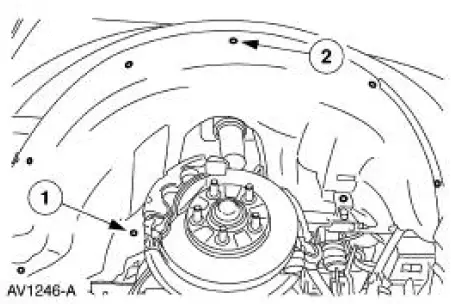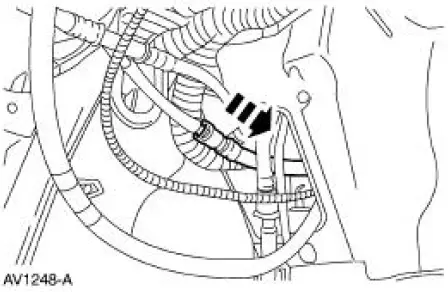Ford Mustang (1999-2004) Service Manual: Evaporative Emission Test Port
Removal and Installation
1. Disconnect the pin-type retainer.

2. Raise and support the vehicle. For additional information, refer to Section.
3. Remove the RH front wheel. For additional information, refer to Section.
4. Remove the RH front splash shield.
1. Remove the three screws.
2. Remove the five pin-type retainers.

5. Remove the evaporative emission test port by disconnecting at the EVAP canister purge outlet tube junction.

6. To install, reverse the removal procedure.
- Leak test the system. For additional information, refer to Evaporative Emission System Leak Test in this section.
- Carry out the evaporative emission repair verification drive cycle. For additional information, refer to Evaporative Emission Repair Verification Drive Cycle in this section.
Evaporative Emission Canister Vent Solenoid
Removal and Installation
1. Remove the canister vent solenoid. For additional information, refer to Evaporative Emission Canister in this section.
 Fuel Vapor Control Tube Assembly Valve
Fuel Vapor Control Tube Assembly Valve
Removal and Installation
1. Remove the fuel tank. For additional information, refer to
Section.
2. Remove the retainers.
3. NOTE: The fuel vapor vent valve, fuel vapor control valve and the ...
 Electronic Engine Controls
Electronic Engine Controls
General Specifications
Torque Specifications
...
Other materials:
Front passenger sensing system
WARNING: Even with Advanced Restraints Systems, children 12
and under should be properly restrained in a rear seating
position. Failure to follow this could seriously increase the risk of injury
or death.
WARNING: Sitting improperly out of position or with the ...
Output State Control (OSC) Mode
Output State Control (OSC) allows the technician to take control of
certain parameters to function the
transmission. For example, OSC allows the technician to shift the
transmission only when he/she
commands a gear change. If the technician commands ...
Assembly
1. Install the locking lever cam and pin.
2. Install the lock actuator lever and pin.
3. Install the lock actuator lever return spring.
4. Install the ignition lock cylinder lockout lever.
5. NOTE: The lock lever with two teeth is installed on the left ...
